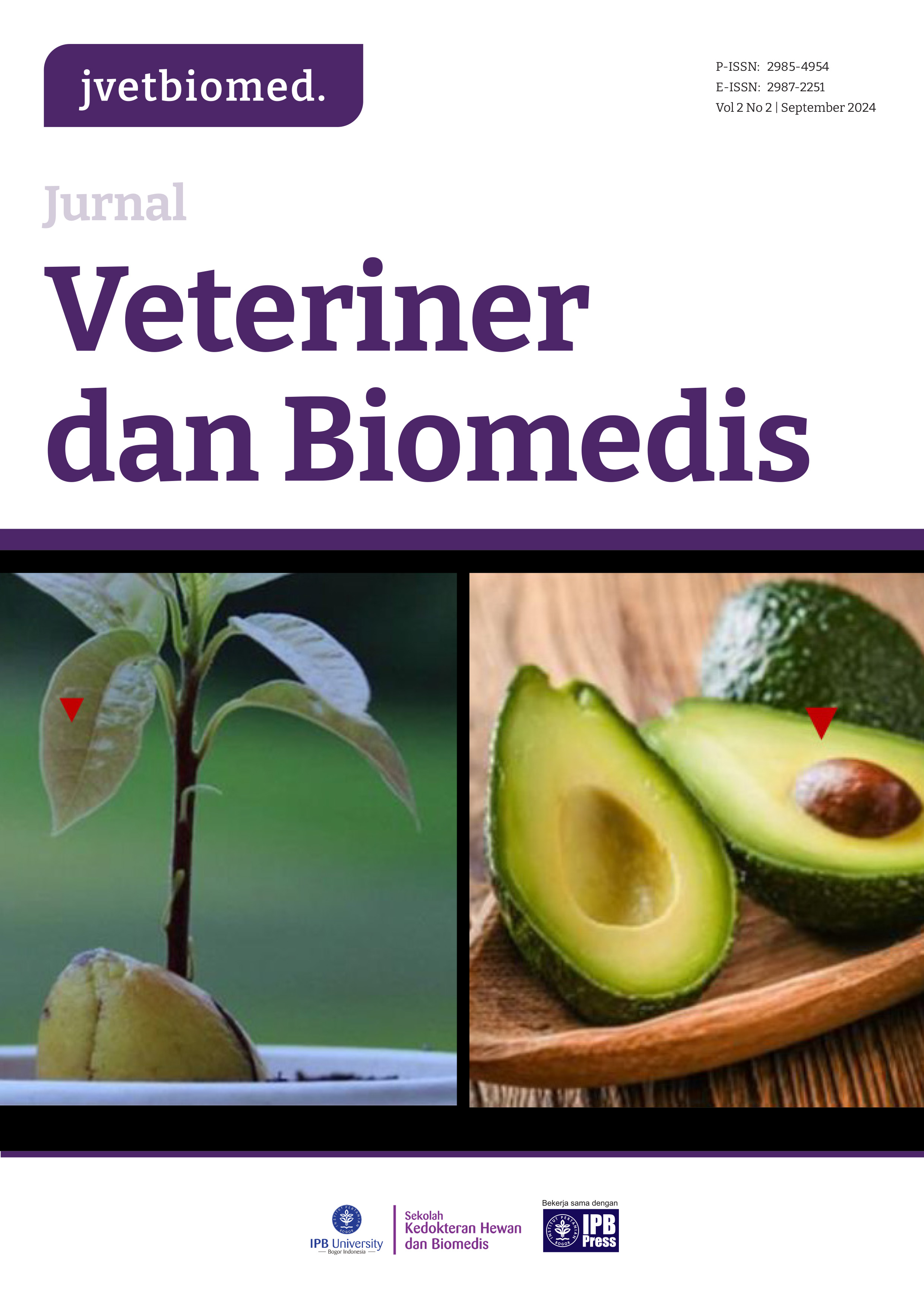Veterinary Public Health Perspectives in the Slaughter of Sacrificial Animals in Bina Widya District of Municipal Pekanbaru
Abstract
The slaughter of sacrificial animals is an annual ritual held by Muslims throughout the world which is directly associated with the potential spread of animal diseases, both non-zoonotic and zoonotic, and the threat to food safety of animal origin. This research aims to collect data from sacrificial officers in 2023 regarding the implementation of aspects of veterinary public health and animal welfare in the slaughter of sacrificial animals. A total of 58 respondents from 45 mosques in Bina Widya District, Pekanbaru City, were surveyed and interviewed purposively. The survey results show that there are two categories of field conditions, namely positive and negative categories with the negative category (72.85%) occupying the largest percentage compared to the positive category (27.15%). The t-test analysis confirmed that there was a significant difference (t statistical > t(0.95) table) between positive and negative conditions in the infrastructure aspect (3.42 > 2.13); sanitation-hygiene of sacrificial workers (6.06 > 2.13); health of sacrificial animals (4.54 > 2.13); sanitation-hygiene of meat/offal (11.15 > 2.13). Significant differences were not confirmed between positive and negative conditions from animal welfare aspects (1.66 < 2.13). Based on the analysis of the average scores, it was concluded that the infrastructure, sanitation and hygiene of sacrificial workers and sanitation and hygiene of meat/offal were in a “very poor” condition (average score < 26.84), and then the animal welfare and health aspects animals are in a “poor” condition (26.84 < average score < 33.45).
References
[2] Budiharta, S. (2009). Penyembelihan, pemeriksaan pramerta dan dan pemeriksaan pascamerta pada ternak potong. Yogyakarta: Gadjah Mada University Press.
[3] Espinosa, R., Tago, D. & Treich, N. (2020). Infectious disease and meat production. Environmental Resource and Economics, 76(4), 1019-1044.
[4] Handoko, J. & Zain, W.N.H. (2012). Kontaminasi bakteri terhadap daging sapi pada tahap pasca-evirasi dan siap distribusi di Rumah Pemotongan Hewan Kota Pekanbaru. Laporan Penelitian. Pekanbaru: Fakultas Pertanian dan Peternakan Universitas Islam Negeri Sultan Syarif Kasim Riau.
[5] Handoko, J. (2016). Implementasi aspek kesehatan masyarakat veteriner dalam penyembelihan hewan qurban di Kota Pekanbaru. In: Proceeding of Seminar Safety & Halal 2016, Semarang. Indonesian Food Technologist. pp.42-46.
[6] Notoatmodjo, S. (2005). Metodologi penelitian kesehatan. Jakarta: Rineka Cipta.
[7] Riwidikdo, H. (2008). Statistik kesehatan belajar mudah Teknik analisis data dalam penelitian kesehatan (plus aplikasi software SPSS). Yogyakarta: Mitra Cendikia.
[8] Rahmi, A., Handarini, R., Faqih, A., Mulyana, D., Kurniasih, D.D., Gagarin, M.Y., Pertiwi, P.P.P., Gumelar, R. & Baharun, A. (2022). Hygiene and sanitation practices in animal qurban slaughter in FMD outbreak. Jurnal Qardhul Hasan: Media Pengabdian kepada Masyarakat, 8(3), 223-228.
[9] Gali, A.U., Abdullah, H.A., Umaru, G.A., Zailani, S.A., Adamu, S.G., Hamza, I.M. & Jibrin, M.S. (2020). Assessment of operational facilities and sanitary practices in Zangon Shanu abattoir, Sabon Gari Local Government Area, Kaduna State, Nigeria. J. Vet. Med. Anim. Health, 12(2), 36-47.
[10] Cook, E.A.J., de Glanville, W.A., Thomas, L.F., Kariuki, S., Bronsvoort, B.M.C., & Fèvre, E.M. (2017). Working conditions and public health risks in slaughterhouses in western Kenya. BMC Public Health, 17(14), 1-12.
[11] Browning, H. & Veit, W. (2020). Is human slaughter possible?. Animals, 10(5), 799.
[12] Sinclair, M., Hötzel, M.J., Lee, N.Y.P., de Luna, M.C.T., Sharma, A., Idris, M., Islam, M.A., Iyasere, O.S., Navarro, G., Ahmed, A.A., Burns, G.L., Curry, M. & Marchan, J.N. (2023). Animal welfare at slaughter: perceptions and knowledge across cultures. Front. Anim. Sci, 4, 1-17.
[13] Tariq, H., Kamal, M.U., Makker, J., Azam, S., Pirzada, U.A., Mehak, V., Kumar, K., & Patel, H. (2019). Hepatitis in slaughterhouse workers. World J Hepatol, 11(1), 37-49.
[14] Rodarte, K.A., Fair, M.J., Bett, B.K., Kerfua, S.D., Fasina, F.O., & Bartlow, A.W. (2023). A scoping review of zoonotic parasites and pathogens associated with abattoirsin Eastern Africa and recommendations for abattoirs as disease surveilance site. Front. Public Health, 11, 1-21.
[15] Fatmawati, M., & Herawati. (2018). Analisa kasus helmintiasis pada hewan kurban di Kota Batu. Indonesia Journal of Halal, 1(2), 125-129.
[16] Swai, E.S., & Schoonman, L. (2012). A survey of zoonotic diseases in trade cattle slaughtered Tanga city abattoir: a cause of public health concern. Asian Pac J Trop Biomed, 2(1), 55-60.
[17] Ningrum, S.G., Soejoedono, R.G., Latif, H., Arnafia, W., & Wibawan, I.W.T. (2016). Prevalence and characterization of Shiga-toxin-producing Escherichia coli isolated from slaughtered qurban animals in Jakarta Province. Media Peternakan, 39(2), 90-94.
[18] Gutema, F.D., Agga, G.E., Abdi, R.D., Jufare, A., Duchateau, L., Zutter, L.D., & Gabriël, S. (2021). Assessment of hygienic practicesin beef cattle slaughterhouse and retail shops in in Bishoftu, Ethiopia: implications for public health. Int. J. Environ. Res. Public Health, 18(5), 1-13.
Copyright (c) 2024 Jully Handoko

This work is licensed under a Creative Commons Attribution 4.0 International License.







